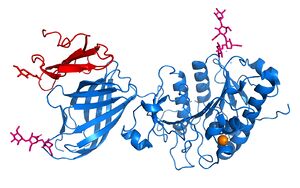Introduction
A lipase is an enzyme that is capable of catalyzing the hydrolysis of fats/lipids which are consumed through oils. It is encoded by the p22 region in chromosome 8. Once synthesized, it is secreted into the interstitial space in several tissues. The main site of action for LPL is in the capillary lumen within muscle and adipose tissue. The function of this lipase is to hydrolyze triglycerides of very low density lipoproteins (VLDL) and to aid in the delivery of lipid nutrients to vital tissues. The enzyme is commonly found on the surface of cells that line blood capillaries. Two different lipoproteins are essential to break down triglycerides. One of the lipoproteins is utilized to transport fat into the bloodstream from different organs. The lipoproteins essential, in the transport of fat from the intestine are referred to as chylomicrons. VLDL are utilized in carrying triglycerides from the liver into the bloodstream. The hydrolysis of triglycerides by lipoprotein lipase results in fat molecules to be used by the body as energy or stored in fatty tissue.
(LPL) is an important enzyme for the breakdown of triglycerides in the body (Figure 1).
[1] 
Figure 1: Purpose of LPL: catalyze the breakdown of a triglyceride into a diglyceride and create one free fatty acid
A
lipase is an enzyme that is capable of catalyzing the
hydrolysis of fats/lipids which are consumed through oils. It is encoded by the
p22 region in chromosome 8. Once synthesized, it is secreted into the interstitial space in several tissues. The main site of action for is in the
capillary lumen within muscle and adipose tissues.
[2] The function of this lipase is to hydrolyze
triglycerides of very low density lipoproteins (
VLDL) and to aid in the delivery of lipid nutrients to vital tissues.
[3] The enzyme is commonly found on the surface of cells that line blood capillaries. Two different lipoproteins are essential to break down triglycerides. One of the lipoproteins is utilized to transport fat into the bloodstream from different organs.
[4] The lipoproteins essential, in the transport of fat from the intestine are referred to as
chylomicrons. VLDL are utilized in carrying triglycerides from the liver into the bloodstream. The hydrolysis of triglycerides by lipoprotein lipase results in fat molecules to be used by the body as energy or stored in fatty tissue.
[5][6]
[7]
[8]
[9]
[10]
[11]
[12]
[13]


